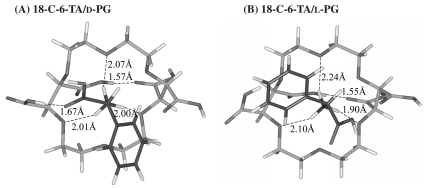Chiral recognition of (18-crown-6)-tetracarboxylic acid as a chiral selector determined by NMR spectroscopy
Abstract
It is shown that the chiral selector

* Corresponding authors
a Department of Chemistry, Yonsei University, Seoul, Korea
b Korea Basic Science Institute, Seoul Branch, Seoul, Korea
c Department of Biochemistry, Yonsei University, Seoul, Korea
d College of Pharmacy, Chosun University, Kwangju, Korea
It is shown that the chiral selector

 Please wait while we load your content...
Something went wrong. Try again?
Please wait while we load your content...
Something went wrong. Try again?
E. Bang, J. Jung, W. Lee, D. W. Lee and W. Lee, J. Chem. Soc., Perkin Trans. 2, 2001, 1685 DOI: 10.1039/B102026I
To request permission to reproduce material from this article, please go to the Copyright Clearance Center request page.
If you are an author contributing to an RSC publication, you do not need to request permission provided correct acknowledgement is given.
If you are the author of this article, you do not need to request permission to reproduce figures and diagrams provided correct acknowledgement is given. If you want to reproduce the whole article in a third-party publication (excluding your thesis/dissertation for which permission is not required) please go to the Copyright Clearance Center request page.
Read more about how to correctly acknowledge RSC content.
 Fetching data from CrossRef.
Fetching data from CrossRef.
This may take some time to load.
Loading related content
